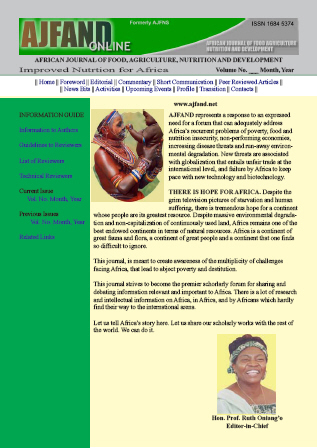
|
African Journal of Food, Agriculture, Nutrition and Development
Rural Outreach Program
ISSN: 1684-5358
EISSN: 1684-5358
Vol. 17, No. 2, 2017, pp. 12092-12105
|
 Bioline Code: nd17042
Bioline Code: nd17042
Full paper language: English
Document type: Research Article
Document available free of charge
|
|
|
African Journal of Food, Agriculture, Nutrition and Development, Vol. 17, No. 2, 2017, pp. 12092-12105
| en |
CHAPTER 14
IDENTIFICATION OF OPTIMAL INVESTMENTS
Lividini, K.; Fiedler, J.L.; Zeller, M.; Asare-Marfo, D.; Funes, J. & Birol, E.
Abstract
Biofortification is regarded as a complement to supplementation, industrial fortification
and dietary diversification in the fight against micronutrient deficiencies. It is important
therefore to first identify areas where biofortification may have high impact and prioritize
these areas for more in-depth analysis. HarvestPlus has developed the Biofortification
Prioritization Index (BPI), which ranks countries globally according to their suitability
for investment in biofortification interventions. HarvestPlus is also conducting ex ante
micronutrient intervention portfolio analyses, designed to simulate the implementation
and impact of a biofortification program in countries which have been identified as
suitable candidates for investment. Micronutrient intervention portfolio studies offer the
ability to distinguish production, consumption and inadequate micronutrient intake at a
more disaggregated level and offer a complementary design and planning tool to simulate
the implementation of biofortification and examine its potential impact and cost-
effectiveness among different approaches. In addition, these studies are designed to
examine multiple interventions within a country, to better understand biofortification’s
role in reducing micronutrient deficiency when considered among a suite of
interventions. This case study of Zambia demonstrates how these tools can be used to
assess the potential impact of biofortification, quantify its cost-effectiveness and examine
how it interacts with and complements other interventions. Given the long-term nature
of biofortification as an intervention investment, future analyses should continue to
incorporate various scenarios including continued investment in sustainable development
and the effects of climate change which are likely to condition the impact of
biofortification and other interventions.
Keywords
Biofortification; Biofortification Priority Index (BPI); Cost-effectiveness; Household Consumption and Expenditure Surveys (HCES)
|
| |
© Copyright 2017 - African Journal of Food, Agriculture, Nutrition and Development
Alternative site location: http://www.ajfand.net/
|
|
